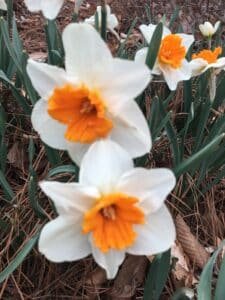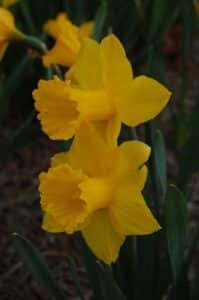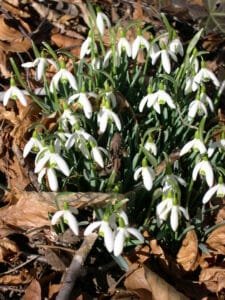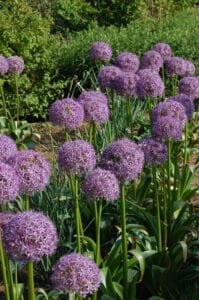7 things to plant to keep deer and squirrels away from your fall bulbs & spring flowers

Paul Cappiello Ph.D.
Yew Dell Botanical Gardens Executive Director
About ten years ago I received a phone call from a local gardener who was distressed over a perplexing garden problem. It seems something was eating her hostas, hydrangeas, tomato plants and even her heavily thorned roses. I suggested that it sounded like she was experiencing midnight raids by members of the Cloven Hoof Gang – easily identified by their black leather jackets and conspicuous antlers sticking out the top of their pompadours. But on that suggestion she responded, “Oh no… that’s not it. I live in the city.” Turns out by “city” she meant Louisville’s Indian Hills neighborhood, home of the biggest herd of hosta-fed deer since the invention of the Zoot Suit.
Living in the Louisville Highlands neighborhood for the last 25 years, I always thought of battling deer in the garden as someone else’s problem. But that was until last year when about a 240-pound doe – and now her three fawns – took up residence in the neighborhood. My garden is now changing focus to all deer-proof, all the time. And now that we’re in bulb planting season, that means I need to completely change my bulb planning.
In the world of spring flowering bulbs, it’s no secret that in the minds of most people, tulips are king. And that’s completely understandable given the gargantuan flowers, stunning colors and, quite frankly the mystique surrounding 17th century Europeans offering up the price of a modest house in exchange for one single bulb. Of course the problem with tulips in the garden is that if you have one single deer within 5 billion miles of a flowering – or a getting ready to flower – tulip, that deer will hop a freight train, thumb a ride and ford the River Kwai to chow down on that tulip bloom exactly 12 hours before it opens! If you have deer, you don’t have tulips. Time to move on…
Enter daffodils.
If you know someone who has never grown a marigold in a Dixie cup who wants to start gardening, daffodils are about as foolproof a starter plant as you can get. In fact they are so forgiving that if someone plants a bunch of daffodils and none of them come up the following spring, they probably shouldn’t be trusted with a trowel ever again. Daffodils are tough, they can endure all manner of horticultural insults and they just keep on going.
The other nice thing about daffodils is that they are generally left completely unbothered by deer… and moles, voles and lions, tigers and bears.
Members of the genus Narcissus, daffodils come in a wide range of sizes, shapes and flower forms – divisions in taxonomic parlance. The smallest top out at less than 6-inches tall and the tallest at almost 30 inches. Of course the genus specializes in yellow but there are pinks, greens, oranges and multi-colors. There are early bloomers and late bloomers. They perform well in full sun or in the light shade of deciduous trees. At Yew Dell we even plant them in containers for moveable spring garden treats. The American Daffodil Society is a great place to start.


But in the deer-proof garden, the bulb display can go well beyond daffodils.
Following is a list of a few of our favorites.
Summer Snowflake (Leucojum aestivum)
In my opinion this is one of the most underutilized bulbs in the garden. It doesn’t make a massive color splash but it is indestructible, grows in sun or shade and lasts forever. Growing 18 to 20 inches tall, it is topped in late spring with delicate white parachute-like flowers that last for weeks and weeks. It is a great partner to typical shade plantings of hostas, ferns, hellebores and epimediums. Excellent in cut flower arrangements.
English and Spanish Bluebells (Hyacinthoides non-scripta, H. hispanica)
A bit shorter than the Summer Snowflake, the bluebells top out at about 15 inches tall with gray/green, strap-like leaf clusters. Small blooms are produced in late spring on upright spikes in a wide range of shades from deep blue to lavender, pink and even white. They work in sun or shade.
Crocus (Crocus species and hybrids)
Crocus are always on the no-brainer list. They are inexpensive to buy and come in a range of colors from white to yellow, orange, pink and purple. They grow in sun and shade and can naturalize – spreading by seed over the years – as long as you don’t use pre-emergent herbicides. About the only pest problem is the occasional industrious squirrel who may “transplant” a few bulbs to the neighbor’s yard.
Snow Drops (Galanthus nivalis)
I never understand why snow drops are not in every garden. They are among the very first signs of life in the bulb garden, sometimes blooming as early as February. Their dainty, white flowers last for weeks and weeks through the time of year that we most need an emotional boost in the garden. They are inexpensive to buy but if you feel the need to go off the horticultural deep end, there are hundreds of cultivars that can set you back a fancy dinner’s cost for a single bulb!

Siberian Squill (Scilla siberica)
If blue is your color, you’re in luck. Siberian squill fills a similar niche to the snow drops but a bit later in the spring season – but it blooms a stunning and most amazing cerulean blue! Squill will naturalize over time in garden beds or even in the lawn. Buy them by the hundred count and spread them everywhere.
Alliums (Allium species)
Otherwise known as… onions… there are dozens of species and hybrid groups for just about any garden situation. Some grow to 4’ tall with massive, amethyst-colored blooms while others can top out no more than 6 inches tall with yellow flowers. Most flower in late spring and early to mid-summer. Some can be a little expensive. All of them are amazing!

This article was originally submitted to the Courier Journal on September 20, 2022.
About the Author

Blurb about Paul here.

